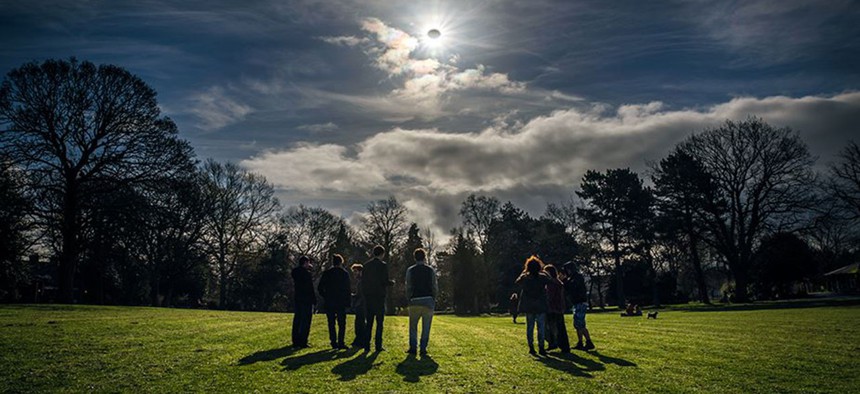
People watch a partial eclipse in Belfast, Northern Ireland in 2015. Robin Cordiner/NASA file photo
How to Enjoy the Eclipse Without Frying Your Eyes
Some tips from NASA and other federal agencies to help you make the most of the rare solar event.
Getting excited for the total eclipse on Monday? It’s a pretty big deal: The last one to hit the continental United States was in 1979.
Watching this spectacle requires some preparation—like spectacles. Looking directly at the sun will literally fry your retinas, so don’t think you can just walk outside and stare up at the sky.
First and most importantly, get a pair of eclipse glasses if you plan to watch in-person. They may look like cheap 3-D glasses, but they’ll filter out harmful rays and give you the clearest view of the sky. Not to mention, they’ll save your eyes from permanent blind spots.
At this point, it’s a challenge to find a pair. Online retailers have either sold out or ratcheted prices up as high as $60 a pair, and many local stores have been cleaned out as well.
That said, there are still a few places latecomers can get glasses before Monday. Check out the Washington Post’s running list of nationwide and D.C.-area vendors who may have them in stock.
Those planning to photograph the event should not only grab a pair of glasses, but also practice with their camera a bit. The eclipse can yield stunning photos regardless of whether they’re taken on a phone or a high-end DSLR, but it may require some special settings.
Fiddle around with exposure, aperture and shutter speeds if possible, and if not, figure out how to manually focus your camera for the crispest shots. Also consider using a tripod to reduce any shakiness that might blur your images. Take a look at NASA’s five tips for getting the best pictures of the sky. Make sure to share your shots with NASA on Twitter using #Eclipse2017 and tagging @NSAGoddard.
For all the people who don’t plan to watch the eclipse in-person, NASA will also stream the event online from 12 locations across the country from 12 p.m. to 4 p.m. EDT. Coverage will follow the path of totality from Oregon to South Carolina.
If you plan on traveling to the path of totality, the Homeland Security Department recommends stocking up on supplies, preparing for traffic and keeping up to date on weather and emergency news. If you can’t make it to totality, you can see how the eclipse will look in your area with this simulator. In D.C., the moon will cover roughly 85 percent of the sun.







